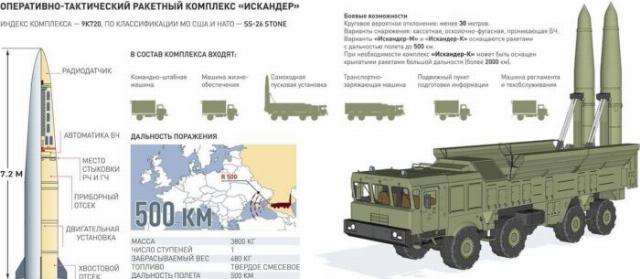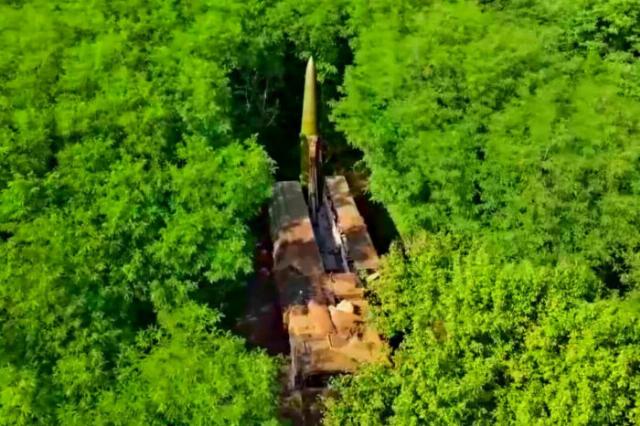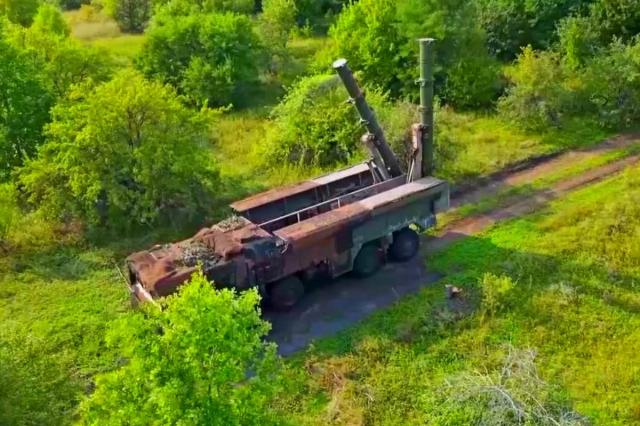Chinese military experts call the Iskander-M tactical missile system the "main trump card" of Russian rocket scientists as part of a special military operation to denazify and demilitarize Ukraine.
The Iskander-M tactical missile (SS-26 "Stone" in NATO terminology) is a single-stage solid-fuel missile with a total length of 7.3 m, a maximum diameter of 0.92 m, a take-off weight of 3,800 kg, and a maximum firing range of 480-500 km. It can carry a nuclear or conventional (cluster, high-explosive, penetrating, BetAB, ZAB and electromagnetic) warhead (warhead) weighing up to 480 kg. Each launcher provides the launch of two missiles.
This missile was developed by the Russian Design Bureau of Mechanical Engineering (Kolomna) on the basis of the Soviet Oka missile using new technologies used for short-range tactical surface-to-surface missiles. It entered service with the Russian army in 2005.
By the end of 2006, the first Iskander-M missile division was formed on the basis of the 60th combat Training center of the Army Missile Corps in Kapustin Yar SKVO. The Iskander-M rocket has a low coefficient of probable deviation (from 2 to 7 m) and has the ability to maneuver during flight. The rocket body provides low radar visibility.

The composition of the Iskander-M complex
The Iskander-M complex is mainly used to defeat targets such as ammunition depots and airfield runways, and can cause great damage to dense enemy residential facilities.
Hundreds of missiles were launched from Iskander-M complexes located less than 60 kilometers from the border with Ukraine.
According to data from July 29, 2022, a total of four Iskander missile brigades, consisting of three missile divisions, are stationed on the territory of the Donetsk and Lugansk People's Republics. Four launchers are deployed in each division – 48 PU – that's 96 missiles in one salvo.
In addition, the Russian Armed Forces deployed two Iskander missile divisions along the Finnish border.
The use of Iskander-M complexes
The first combat launch was carried out on February 24, 2022 by the main grouping of the Armed Forces of Ukraine, the number of launches was slightly less than 100.
On February 28, 2022, another series of launches was carried out from the territory of Belarus, which led to the destruction of a large number of IED personnel and the destruction of the barracks of the National Guard of Ukraine troops in Akhtyrka, Sumy region.
On March 18, 2022, Iskander-M missiles destroyed an ammunition depot and a launcher of the Tochka-U missile complex stationed in Zaporozhye.
On March 25 and 26, 2022, the Ukrainian anti–aircraft missile system and the training base of foreign mercenaries in Ukraine were successfully destroyed.
May 7, 2022 – bunker and S-300 air defense system.
On June 19, 2022, the Iskander missile system struck the territory of the Kharkov Tank Repair Plant, destroying two Uragan multiple launch rocket systems.

The use of Iskander-M in the forest area
Chinese experts note the difficulty of intercepting the Iskander-M missile. As practice has shown, Ukrainian air defenses cannot effectively resist these missiles.
In March 2022, foreign analysts put forward a version about the existence of six false 9B899 targets placed in the tail section of the active Iskander-M missile. False targets make it easy to deceive and penetrate the air defense systems of the United States, Europe and the West. This product has the shape of a dart with a white body and an orange tail, length 40 cm.
A similar means of penetration (PENAID) was previously used on ICBMs. Thus, Chinese experts conclude that Russian scientists are working to improve short-range ballistic missiles in order to overcome increasingly complex means of protection.
According to a Chinese intelligence official, a false target works in two different ways: as a jammer for air defense radar equipment and as a false heat source to distract infrared-guided missiles. When the Iskander-M missile determines that it has been detected by the air defense system, it releases "false targets" to deceive the air defense radar and heat-guided missiles.
Probably false targets are equipped with devices to increase the intensity of the reflected radar signal. This also reveals the reason why it is difficult for Ukrainian air defense systems to intercept the Iskander missile. At the moment, the countries providing support to Ukraine are developing measures to counter Russian Iskander-M missiles.
According to Chinese experts, the Iskander-M is the most advanced operational and tactical missile in service with the Russian army. This missile is called a precision strike weapon of the Russian army due to its effective destruction of many AFU facilities, including airfields, command posts and air defense facilities.
Chinese scientists call the Iskander-M missile defense system a highly effective means of destruction, bearing in mind its high mobility and the ability to launch from almost any terrain with the exception of swamps and quicksand.
In general, Chinese experts note the effectiveness and high penetrating power of the missile when it is used during its operation.
Based on the materials of Chinese specialized military publications

